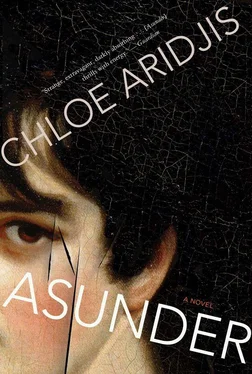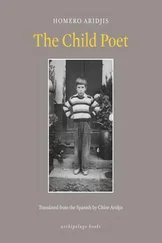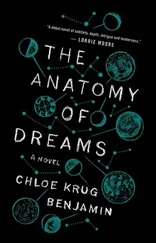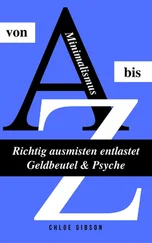At first Daniel was sceptical, frowning as he listened to my decision, but after a few days he rang up and gave his support and even confessed to sometimes having wondered whether like my great-grandfather I would turn grey and hunched in the rooms of the Gallery, a fate I often thought I’d share with him.
After the destruction of my objects it took weeks to accustom myself to their absence. Each time I entered my room I’d look over at the empty shelf expecting to see them, the way you glance at the same spot on the wall where you once found a large spider, half hoping, half dreading, to see it there again although you removed it with a glass and paper long ago. One evening I finally moved an armful of paperbacks to the shelf and propped them up with tea tins full of gravel and, with that, the imprint was gone.
In bed at night, and during lulls at the Gallery, the chatelain would come lurching into my thoughts. Sometimes I could see his face, but often it was only the back of him or that first glimpse from afar, a human-size clump of ashes blown out of the fireplace. Over the weeks he began to feel about as real as Daniel’s Hungarian hypnotist, and I wondered whether this would end up being the story I’d carry round and sometimes unfold from my pocket. Marc Cointe quit the real, Pierre had said, but maybe he’d never belonged to it. Each time I doubted I’d pull out the evidence and lay it on the table: four witnesses, a printed obituary with a photograph, and, not least, the scar on my cheek, now a groove so pale I had to tilt my head under a bright light to locate it in the mirror. All real.
Late one afternoon a young sketcher entered my room at the Gallery with his notebook. Dark hair in a ponytail, always the same beige vest and scuffed suede boots. I’d seen him many times before. He sat down on the bench and began sketching Giovanni Bellini’s Madonna of the Meadow so feverishly he seemed to forget everything but himself and the painting. I strained to get a better view but my seat was too far away. He was working with such intensity, my curiosity grew and grew, and I finally got up and walked around, pretending to check something behind him, and was more than a little surprised when I glanced down and saw that instead of a sweet infant Christ the Madonna was holding a foetus with enormous eyes and frog-like hands, its fingertips like suction cups and toothed circular mouth a red sea anemone that seemed to move on the page. Given his docile manner I’d always assumed the young sketcher was producing elegant, faithful copies of the works in our Gallery, not mangling them. The Madonna — beautifully rendered, he was an excellent draughtsman — was cradling a baby Jesus from outer space.
Four weeks passed in a gust.
At the start of my final day, not wanting to rush, I set out for work half an hour early. ‘There are beggars and buskers on this train. Please do not encourage their presence by supporting them,’ said the announcement on the Tube, but that morning I encouraged them with small coins, those tiny acts of generosity you’re prone to when feeling, however briefly, that the universe is finally on your side.
As I stood in the threshold of 45 and 46 watching strangers fill the rooms, my head began to swarm with images from the past and present, like in those old paintings or, more often, panels, with continuous narrative, in which different scenes or chapters of a saint’s life crowd the same space with little perspective, and I thought back on my years at the Gallery, the thousands of hours spent standing and sitting, watching over immobile images and mobile figures, and I wondered what I would miss. It had been a second home, this geometry of square rooms, rectangular halls, circular junctions between quadrilaterals, the links, axes and extensions, the vestibules and sub-vestibules… But apart from Roland and the St Jeromes, it was hard to tell what else might return in dreams; only later would I know.
At 6.10 in the changing room, I began saying farewell to my uniform. I removed my jacket and laid it on the bench, brushing off two strands of hair from the collar. I undid the button and zip and stepped out of my trousers, taking time to pull each leg out. Then came the seven buttonholes down my chest, which I tackled as slowly as I could. Once freed from the lilac blouse, I folded it neatly and also laid it on the bench though I knew everything would soon be tossed into the wash. I was sad to give up the purple tie but knew I’d never wear it in the real world.
The museum stayed open three hours later on Fridays but unless we regulars worked overtime, our shift would end at the usual hour and part-timers would come in and take over from six to nine, a comfortable relay though I’d miss hearing Henry’s jangling of keys, and it always threw me off a little to see unknown faces in the changing rooms as I was getting ready to leave.
That evening I didn’t head out once I had put on my civvies. Instead of making my way to the exit as I normally did, I returned to the second floor in my black wool skirt and high boots, ones I’d treated myself to the week before to mark the end of an era, and crossed section after section of my former kingdom, past men and women in grey, many of whom I didn’t recognise, past paintings whose shapes and colours I registered out of the corner of my eye, and kept walking until I reached Room 30.
Two men, Spaniards I think, were standing in front of her speaking loudly and gesturing. One of them moved his hand across the air as if following the contours of her body, the slope of her shoulder and the dip at her waist, while the other nodded in agreement and then repeated the movement. I waited until they had walked off.
It had been a while since we’d been face to face. I drew near for a close look. I was struck by how calm she appeared, at such peace in her salmon-pink boudoir, so oblivious to the strong emotions she’d stirred up in men and women over the years, and wondered whether if I stood there long enough some of this dignified calm would seep into me. I could almost feel the warmth of her enclosure, the brush of silks and satins, the sound of her breath as she gazed into the mirror Cupid held up. I’d rarely, if ever, seen such a beautiful body, a smooth and perfect arabesque, the kind any woman would dream of having.
As I stood there I noted a detail not in the paint layer but in the painting, something guides would often mention, the fact that the face in the mirror and the pearly woman outside didn’t match up, a disjunct between the reflection and the reflected. The face in the mirror was rounder and swarthier, one could see, out of focus and hard to read, while the face outside, at least judging from the one-quarter profile, seemed to belong to someone paler, more delicate and ideal. Light outside, shadow in the mirror, perfection beyond, something rougher in the reflected.
I took a few steps back and sat down on the leather sofa facing the painting. Yes, I could still see the dissonance, and for the first time it bothered me. I stood up again and returned to the painting, leaning further in to inspect the face in the mirror once more, but now instead of Venus’s blurred features another face appeared, that of a pale woman with a jagged black fringe and longish nose, her eyes searching and intense, and I blinked a few times to make sure I wasn’t imagining things, but no, for a few seconds a very familiar face gazed back out at me, and I wondered whether Mary Richardson too had quick glimpse of herself in this mirror.
‘Excuse me, Miss… Excuse me?’
I turned towards the voice. It belonged to woman in uniform, with greyish eyes and six silver hoop earrings climbing up her ear.
‘Could you step back a little, please?’
I obeyed.
‘A little more?’
Читать дальше












